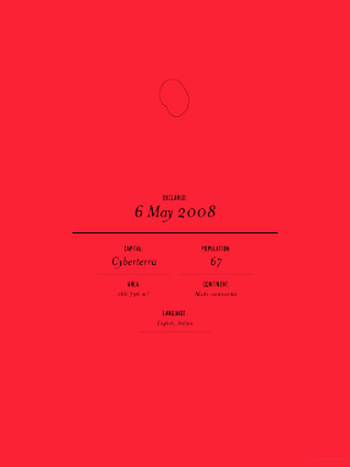The City of Cyberterra was founded on 8 September 2002 [J2Μ17J2002] as a metrosite or virtual realm. The City of Cyberterra, through the Cesidian Root utility company, used to maintain an Intercontinental Internet, a system of multiple servers in Europe, North America, and Asia carrying the entire contents of 5 or more different alternative roots. Later the City of Cyberterra also acquired a geographical consistency, and became the world's first cybernetic realm or kyvernítis (κυβερνήτης).

Page 225 of An Atlas of Countries That Don't Exist
The City of Cyberterra was governed by the Mayor of Cyberterra, Kaisiris Tallini — aka Cesidio Tallini. Like any other major city, the City of Cyberterra also has a time zone or local time, which in this case is Cyberterra Mean Time or CMT, which follows the UTC+1 hour standard ― Cyberterra does not observe summer or daylight savings time.
The City of Cyberterra not only has its own specific time zone, but in fact follows an entirely different new date and time format.
The Cyberterra Mean Time (CMT) standard is simply the UTC+1 hour time standard. The Cyberterra Mean Time (CMT) standard was also known as the Fifth World Chronological Standard.
The Cyberterra Mean Time (CMT) format, on the other hand, is a combination of the Cesidian calendar date and Swatch Internet Time. The Cyberterra Mean Time (CMT) format was also known as the Fifth World Chronological Format.
On 3 January 2010, the Mayor of Cyberterra established the terrestrial coordinates of Cyberterra by convention to be 43°0'0" North and 15°0'0" East. This corresponds to this point in the Adriatic Sea:
https://latitude.to/articles-by-country/general/1628/adriatic-sea
This action turned the City of Cyberterra also into a cybernetic realm (or κυβερνήτης ― kyvernítis).
On 17 February 2010, the Mayor of Cyberterra established the IL6 code as the amateur radio call sign for Cyberterra by convention. The IL6 call sign is the non-official one used for the Adriatic Sea islands of the Italian regions of Marche and Abruzzo.
The City of Cyberterra is also a city you can tie your dwelling or building to, regardless of where you live on Earth. Cyberterra is one of the Cesidian law jurisdictions. Cesidian law jurisdictions 1) follow Cesidian law as a common law standard; 2) observe the Cyberterra Mean Time (CMT) standard and format as a time standard and chronological format; and 3) allow Paradiplomatic Affairs (PdA) professionals to practice within their dwellings or buildings.
The Patron Saint of Cyberterra is Saint René Descartes. The Feast of Saint René Descartes falls on 13 December in the Gregorian calendar, or 9 Nureyev in the Cesidian calendar.
The City of Cyberterra was also the virtual and cybernetic capital of the United Micronations Multi-Oceanic Archipelago (UMMOA).
Cyberterra's closest island is terra nullius
According to the scholar Jeanne Desmarets, who has done research on the foreign and diplomatic policy of the Republic of San Marco (Venice), and especially its relations with the Republic of Ragusa (Sicily) and the Ottoman Empire, in the Treaty of Rapallo of 1920, the issue of the island of Lissa (Vis), and the nearby islands of Busi (Biševo), Sant'Andrea (Svetac), and Pomo (Jabuka), which had first been insistently requested from Italy together with the islands of Carnaro, Pelagosa, and Lagosta, was resolved by saying that they were under the sovereignty of the Kingdom of the Serbs-Croats-Slovenes. Yet Pomo (Jabuka) is not expressly mentioned as the other two islands — apparently Busi (Biševo) and Sant'Andrea (Svetac) — in the Treaty of Rapallo (1920), so Pomo (Jabuka) may actually be terra nullius, or "nobody's land" in disguise.
References
Articles
- DCP: 43 degrees north, 15 degrees east, by Agnes Fakesch and Christian Kapik, The Degree Confluence Project, 15 May 2007
- Jabuka (or Pomo Island) Map — Split-Dalmatia, Croatia, Mapcarta, 2008
- De países inexistentes y vidas imaginarias, 16 March 2017
- Eso que llaman patria, by Javier Reverte, 10 April 2017
Dictionaries
- CMT acronym meaning, All Acronyms, 12 March 2016
- CMT acronym meaning, Acronym Finder, 12 March 2016
- CMT acronym meaning, Abbreviations.com, 12 March 2016
- CMT acronym meaning, AcronymsandSlang.com, 15 October 2022
Books
- An Atlas of Countries that Don't Exist: A Compendium of Fifty Unrecognized and Largely Unnoticed States, by Nick Middleton, Chronicle Books, 28 March 2017, page 225
See also
- Cyberterra Mean Time
- Cesidian law jurisdiction
- United Micronations Multi-Oceanic Archipelago
- Fifth World Chronological Standard